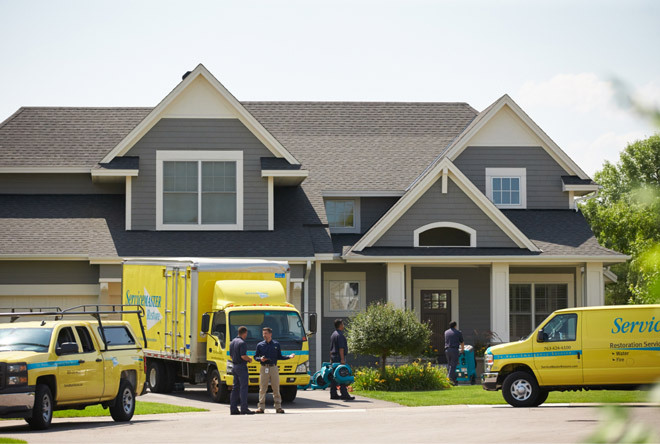water restoration Process
When you work with ServiceMaster, you can trust that you are working with an experienced company with a proven process for success. While every situation is unique and there are differences related to water restoration, fire restoration, mold remediation and our other services, utilizing a proven process is a key factor in our success.
Example - A Typical Water Restoration Project
Our fist step is to walk you through our Recovery Guide before any mitigation works begin so we can answer any of your questions.
1. Identify the Source of the Problem and the Scope of the Damage
From here we do a thorough examination using specialized moisture-detection meters, probes and sensors to determine the extent of the damage so we can develop an effective plan for returning your property to its pre-loss condition. We inspect and tag items for your insurance company and provide photographic documentation.
Areas We May Inspect
- Attic - Wet insulation, framing or stored contents may need to be treated.
- Basement or Crawlspace - Identify an areas of possible water seepage.
- Ductwork - Look for water intrusions through affected areas, including floor vents.
Evaluate Carpeting
Based on the amount of damage, we may be able to leave the carpet and pad in place to dry. In more severe cases, however, we will remove the pad to prevent microbial growth and create a better environment for dehumidification or possibly replace both the carpeting and pad.
Evaluate Other Flooring
We will then evaluate your tile, vinyl, laminate or hardwood floors to determine whether these areas can be effectively dried or if it is more cost effective to replace them. During this process, we often have to remove the flooring to address moisture trapped beneath the surface and determine whether the subflooring needs to be dried or replaced.
Evaluate Walls, Ceilings and Cabinets
In many situations, removing baseboards is required to address moisture trapped between the baseboard and the wall. We may also drill holes in walls, sheetrock and ceilings to allow trapped moisture to escape, prevent microbial growth and limit further damage. Still, in many cases, drywall and sheetrock will need to be replaced.
Protect Your Contents
Our goal is to not only protect your contents from further damage, but to create a more efficient environment for faster and more complete drying. Protecting your contents may include moving items into another room, setting items up on blocks or moving them off-site.
2. Perform Water Extraction
Once the inspection process is complete, we can begin the water extraction process. This may include:
- Placing, setting up and installing dehumidifiers
- Placing, setting up and installing high velocity air movers
- Applying antimicrobials
- Applying odor controls
3. Explain Future Visits and Expectations
While the area is being dried, we discuss follow-up steps, including moisture readings, monitoring equipment, repositioning equipment, etc. While every instance is unique and drying times will vary, these additional visits ensure rapid drying and progress toward returning your home or business to normal.
4. Perform Reinstallation and Cleaning
Reinstallation includes restretching, reattaching the tack strip and repairing the seams and thresholds. After the reinstallation, the carpet is cleaned and deodorized. During this phase, any upholstery or other damaged furnishings will be cleaned.
5. Structural Repairs
If applicable, after the drying process is complete, structural damage is assessed and the repair phase can begin. At this time, drywall, ceiling and floors will be repaired. If the carpeting was not salvageable, new carpet and pad will be installed. In many cases, it is more appropriate to complete structural repairs before reinstallation and cleaning.
Summary
During the entire process, a dedicated project manager is charged with overseeing the activity and communicating with you and your insurance provider so that your space can be restored to its pre-loss condition as quickly and cost effectively as possible.


